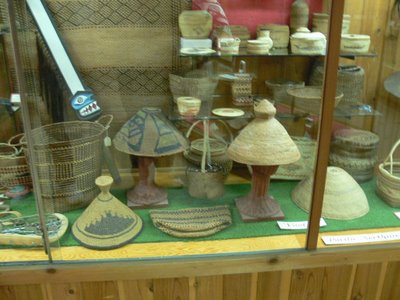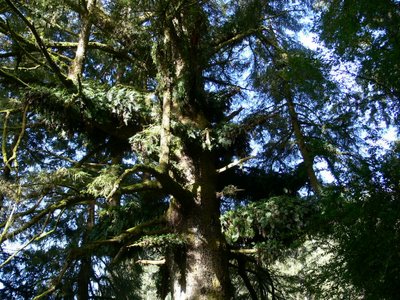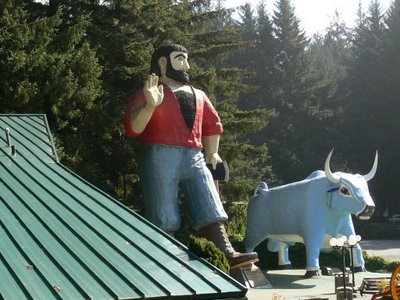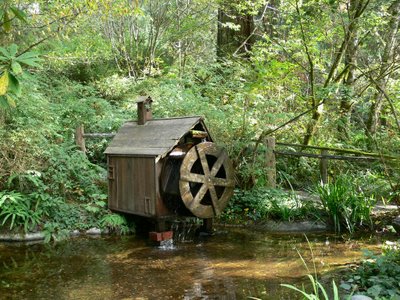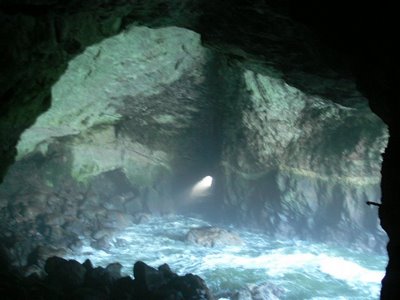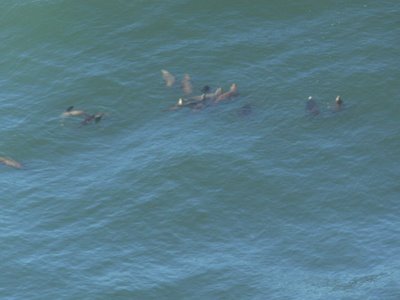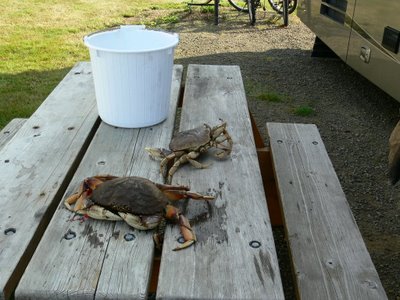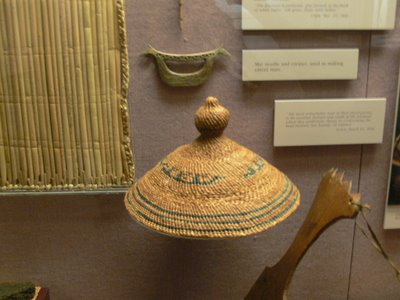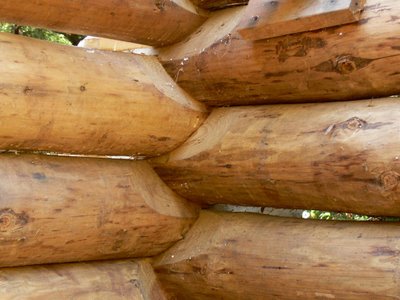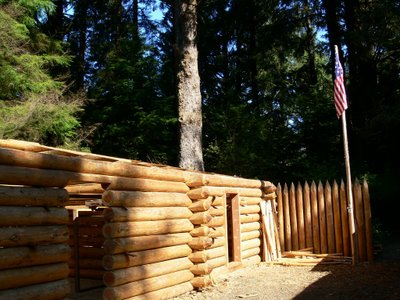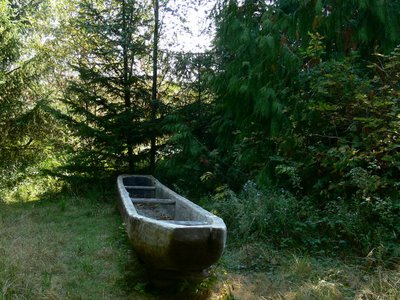Come along with us as we travel across America. Gary wants to catch a fish in every state.
Monday, October 23, 2006
Trees of Mystery, Klamath, Ca
We visited the Trees of Mystery in Klamath. Cost was $13.50 per person. They also have a sky tram and an Indian Museum. We enjoyed seeing all the trees and the wood carvings that told the story of Paul Bunyon. The Indian Museum was also great.
Trees of Mystery
Trees of Mystery, Klamath, ca
Fern Canyon
Friday, October 20, 2006
Klamath River RV Campground
Elk Preserve, Reedsport, Oregon
 You can see how the colors are changing in this part of Oregon
You can see how the colors are changing in this part of Oregon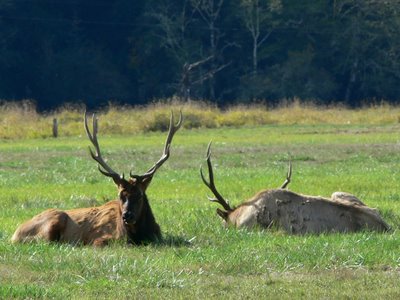 They have an elk preserve outside of Reedsport, Oregon. These two bulls were just lieing around enjoying the warmth of the sun.
They have an elk preserve outside of Reedsport, Oregon. These two bulls were just lieing around enjoying the warmth of the sun. There were two gagle of geese at the Elk preserve. A coyote began to chase the first gagle. When he did so, this gagle snapped to attention.
There were two gagle of geese at the Elk preserve. A coyote began to chase the first gagle. When he did so, this gagle snapped to attention. 
Outside Florence, Oregon
Thursday, October 12, 2006
Tillamook, oREGON
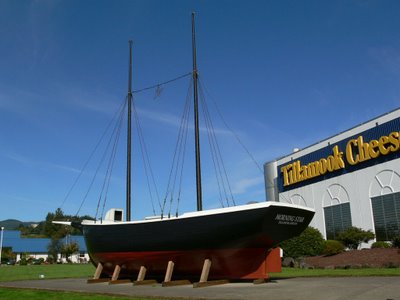 While in Tillamook we visited the Naval Air Museum and the Tillamook Creamery. The Naval air museum is housed in the largest wood building in Oregon. The building was built to house blimps that were used to cruise over the Pacific in search of enemy subs. The creamery tour was okay. We enjoyed tasting the cheese, cheese curds are wonderful, and of course the ice cream. Gary had strawberry but I thought I would try something different, so I had white licorice. Really tasted great.
While in Tillamook we visited the Naval Air Museum and the Tillamook Creamery. The Naval air museum is housed in the largest wood building in Oregon. The building was built to house blimps that were used to cruise over the Pacific in search of enemy subs. The creamery tour was okay. We enjoyed tasting the cheese, cheese curds are wonderful, and of course the ice cream. Gary had strawberry but I thought I would try something different, so I had white licorice. Really tasted great. 
Evergreen Air Museum
We really enjoy visiting air Museums. This air museum is located in McMinnville, Oregon. It is the home of the Spruce Goose. We arrived in time to take a guided tour. We have discovered that taking the guided tour is well worth the time. We really liked the way that they displayed the planes in this museum. The information boards for the planes were the best we have seen in all of our air museum visits. The cost for the museum was $12 each. They also have a very nice snack bar.
Evergreen Air Museum
Saturday, October 07, 2006
Pacific City, Oregon
We are currently camped at the Thousand Trails camp in Pacific City, Oregon. Great campground except that I cannot get out with my Datastorm. WiFi is available, but it is so much easier to download the pictures to webshots from the comfort of our rig. We have visited two great air museums. I will be posting pictures when I am able to get out with my datastorm. We will also be going into Tillamook to visit the factory. Everyone tells us that we need to get some of their ice cream. It is amazing to see all the fishermen. In some places I swear that they are elbow to elbow on shore not to mention the numerous boats that can be seen. The salmon are running. Gary will be trying his luck one day next week.
Monday, October 02, 2006
1900s shipwreck
Fort Clatsop National Park
Fort Clatsop National Park is located near Astoria, Washington. We were able to view two short films about the Lewis and Clark Expedition. The replica of the fort was burnt last year and they are in the process of rebuilding it. They are using the plans from the original fort. They have a few displays inside the Visitor Center. I took a few more pictures that can be found on the travel photo link. Gary and I really enjoy walking the the footsteps of history.
Sunday, October 01, 2006
Fort Clatsop, Oregon
Fort Stevens, Washington
We visited Fort Stevens in Warrenton, Washington. Fort Stevens was first established during the Civil War to add protections in case England tried to enter the war on the side of the Confederates. Various changes took place at the fort during the later years. During WWII a Japanese sub fired upon the fort from 12 miles out on the Columbia River. The Commander at Fort Stevens did not fire back as he did not want to give away his position and besides, his guns could only fire 9 miles. After the war, the pilot of the plane who was aboard the sub at the time of its firing upon the fort, told the Americans that the Japanese fired hoping that the explosions would cause and American ship to respond so it could be sunk, The Japanese did not know that there were guns protecting the Columbia River. The batteries were covered with mounds of dirt and could not be seen from the river. The army had 3 batteries that protected the Columbia River. Fort Stevens also laid mines in the Columbia River to keep out large battleships. After WWII, the fort was decommissioned and the guns that were left were dismantled. One of the 10" guns was literaly broken into pieces that could be carried by one man as the battery and gun had been covered with cement and the stairs leading out of it were only wide enough for one man.
Fort Stevens, Oregon
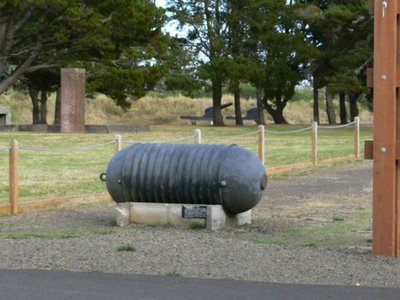 Mines like this were used to mine the Columbia River during WWII. They were tested at Fort Stevens before being placed in the River.
Mines like this were used to mine the Columbia River during WWII. They were tested at Fort Stevens before being placed in the River.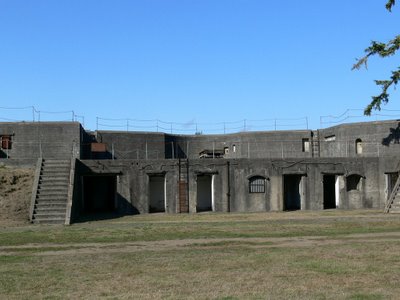 One of the 3 batteries at Fort Stevens, Washington.
One of the 3 batteries at Fort Stevens, Washington. This is a replica of a 8" gun being built at Fort Stevens, Washington. If you notice the top of the concrete you can see that it is beveled. The gun was hidden below the wall and it would be raised up to fire at enemy ships if the need were to arise. The batteries were not able to be seen from the River. The ammo was stored below in the battery.
This is a replica of a 8" gun being built at Fort Stevens, Washington. If you notice the top of the concrete you can see that it is beveled. The gun was hidden below the wall and it would be raised up to fire at enemy ships if the need were to arise. The batteries were not able to be seen from the River. The ammo was stored below in the battery. 
Subscribe to:
Comments (Atom)


